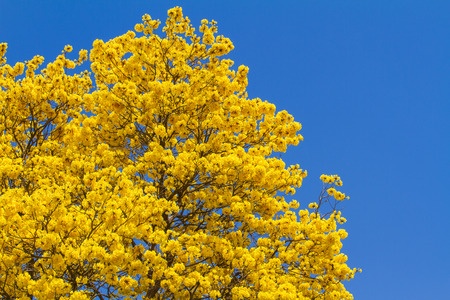Tahuari - Tabebuia serratifolia

Common Names: Tahuari, Tahuwari, Yellow Lapacho, Yellow Pau d’Arco, Yellow Poui, Yellow Ipe, Pau d’arco Amarelo, ipê-amarelo, Tabebuia serratifolia
Latin Name: Tabebuia serratifolia
Origin: South America
Short Introduction
There is limited cultivation information available for Tahuari. Most sources agree that the seeds should first be soaked in warm water and then planted in a swelling or indoor substrate. Tahuari adapts to a wide range of soils, but optimal growth requires a warm location without risk of frost. Although it tolerates prolonged dry periods, it prefers rich, well-drained soils. It will thrive in clay or sandy soil across a wide pH range. Basic tree care includes regular pruning and occasional bark removal. Tahuari is highly resistant to fungi and various other pests, and does not demand extensive maintenance. Its wood is prized for strength and durability, and many countries cultivate Tahuari primarily for its outstanding building qualities.
Detailed Description
A legendary tree with mystical properties from the depths of the rainforest.
Botanical Information
Tahuari (Tabebuia serratifolia) is a tall, robust tree native to South America, capable of reaching nearly 35 meters in height, with some specimens recorded at up to 46 meters. The trunk is massive, averaging around three meters in circumference. Although its benefits have been known for centuries—and the trees themselves can live for up to 700 years—Tahuari only became known to Western civilization in the early 19th century. The tree’s grayish-brown bark is rough, cracked, and appears dry, with a soft, beige-yellow, and slightly sweet interior.
The wood is hard and durable, traditionally used in shipbuilding, bows, weapons, and spears. Leaves are elliptic, can twist into various shapes, are glossy, and generally brownish in color. The beautiful, bell-shaped flowers are golden-yellow (occasionally white or purple), with elongated fruits (15–60 cm) and gray-brown, winged seeds. In phytotherapy, the bark, leaves, and flowers are used.
Origin and Distribution
Tabebuia serratifolia originates from the rainforests of South America. Though globally recognized today for its therapeutic properties, indigenous communities have known and used this tree for centuries, while the Western world only began to take note about 100 years ago. Its native home includes the Amazon highlands of Peru (around 800 meters above sea level), but it also grows in Latin America, Brazil, Bolivia, French Guiana, Paraguay, and northern Argentina.
Usage / Dosage
The compounds in Tahuari have shown promise in diabetes management. Clinical studies indicate that Tahuari constituents may lower peripheral blood sugar, increase tissue sensitivity to insulin, and positively alter several diabetes indicators, making them potential candidates for diabetes prevention—although further confirmation is needed. Research also shows promising results for supporting healthy blood pressure in combination with antihypertensive medications.
Tahuari’s active ingredients demonstrate notable potential in supporting immune function, especially in aiding repair mechanisms during cancer (including metastases). Current data suggest that, alongside conventional cancer treatments, Tahuari can serve as a supportive supplement, possibly reducing side effects of chemotherapy and radiotherapy.
Extracts or infusions from Tahuari support the development and function of the immune system. Traditionally, it’s recommended for yeast and fungal infections, both internal and external, as a broad-spectrum natural antibiotic and antifungal agent. Preparations may also be used for fevers, colds, and general inflammatory conditions—helping reduce fever, activate immune cells, suppress infection, and support healing across multiple levels. Tahuari also supports respiratory health by reducing infections and alleviating various types of cough—including suppressing dry cough and easing expectoration of moist coughs.
Tahuari compounds may promote liver regeneration, help treat viral hepatitis, and aid in detoxifying the body by binding impurities and heavy metals in the bloodstream. They may help dissolve gallstones, support the biliary system, aid digestion, heal gastric and intestinal ulcers, enhance metabolism, and dissolve uric acid, making it a helpful aid in arthritis and inflammatory joint conditions.
Folk traditions suggest its use for gynecological issues and mild menstrual pain. It may support healthy blood composition, encourage production of both white (immune function) and red blood cells, combat anemia, improve circulation, strengthen cardiac activity, and benefit skin by reducing sensitivity and supporting healing in conditions such as eczema.
Tahuari may provide relief for insomnia, fear, and anxiety, and, especially in combination with lifestyle interventions, may help reduce stress and improve sleep quality.
For continuous herbal therapy, it is recommended to use Tahuari for no more than three months at a time, pause for one month, then, if desired, start another three-month cycle. For cancer supportive care, it may be used together with Cat’s Claw (Uncaria tomentosa). Notably, Tahuari and Lapacho are distinct: while both come from Tabebuia trees, Tahuari is prepared strictly from the inner, soft bark of one specific species, whereas Lapacho is made from the outer bark of any Tahuari species.
Active Compounds
Major bioactive constituents include naphthoquinone derivatives—especially alpha-lapachone and dehydroisolapachone—alongside alcohol derivative lapachol, catechins, flavonoids (flavones, flavonols, flavanones), saponins, and important organic acids (notably trihydroxybenzoic, veratric, and vanillic acids). Tahuari also contains beta-sitosterol, beta-carotene, vitamin C, nicotinic acid, thiamine, riboflavin, and a range of minerals: chromium, manganese, phosphorus, magnesium, iron, zinc, silicon, potassium, tin, and calcium. Lapachol, in particular, is noted for anti-tumor, anti-inflammatory, and antibacterial effects under certain conditions.
Traditional Dosage
Unless otherwise therapeutically indicated, the typical preparation involves one tablespoon (about 2–3 g) of Tahuari, steeped in 1 liter of cold water and simmered for 20–30 minutes. Alternatively, after boiling, the infusion may be steeped gently for an additional 20 minutes. Strain the liquid and drink one glass (about 200 ml) three times daily during or after meals.
Do not exceed the recommended dose; Tahuari should not be used by pregnant or breastfeeding women or children. If used in compound preparations, adjust method according to other ingredients.
